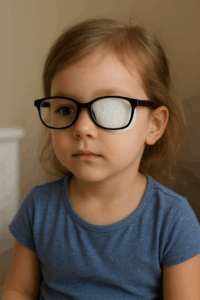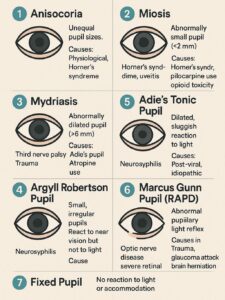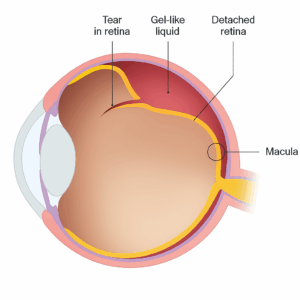
Anushka Super Speciality Eye Hospital
Call: 90044 44422 / 99213 44422 | Timings : 8.30 a.m to 5.30 p.m (Mon-Sat) | Add: Shri Swami Samarth Soc, Kaneri Dhamankar Naka, Bhiwandi




Accredited for Quality Care
Blepharitis: Types, Causes, and Effective Treatments
anushka
18 August 2025
What is Blepharitis?
Blepharitis is an inflammation of the eyelids, typically occurring at the base of the eyelashes. It can affect one or both eyes and is often a chronic condition. People with blepharitis usually experience symptoms like redness, swelling, irritation, and crust formation on the eyelashes.
Although it is rarely sight-threatening, blepharitis can cause discomfort and, if left untreated, may lead to complications such as dry eye syndrome, styes, or chronic conjunctivitis.
Types of Blepharitis
Blepharitis is generally categorized into two main types based on the location and underlying cause:
1. Anterior Blepharitis
- Affects the outer front edge of the eyelid, where the eyelashes grow.
- Common causes include bacterial infection (usually Staphylococcus) or skin conditions like seborrheic dermatitis and dandruff of the scalp and eyebrows.
- Symptoms may include flaking at the lash base, redness, and itchiness.
2. Posterior Blepharitis
- Affects the inner edge of the eyelid (in contact with the eyeball) and is often linked to dysfunction of the meibomian glands (oil glands in the eyelids).
- Often associated with skin conditions like rosacea and acne.
- Symptoms include greasy flakes, frothy tears, eyelid swelling, and a burning sensation.
Causes of Blepharitis
Blepharitis can be triggered by multiple factors, often overlapping:
- Bacterial Infections
- Staphylococcal bacteria are a common cause of anterior blepharitis.
- Chronic bacterial presence can lead to eyelid inflammation.
- Meibomian Gland Dysfunction (MGD)
- Poor oil secretion from the glands results in abnormal tear film, causing irritation.
- Skin Conditions
- Seborrheic dermatitis, rosacea, and eczema can contribute to eyelid inflammation.
- Allergies
- Allergic reactions to eye makeup, contact lenses, or environmental factors can cause blepharitis-like symptoms.
- Parasitic Infestation
- Demodex mites living in eyelash follicles may cause chronic blepharitis in some individuals.
- Dry Eye Syndrome
- Reduced tear production worsens eyelid inflammation and irritation.
Symptoms of Blepharitis
While symptoms may vary from person to person, common signs include:
- Red, swollen eyelids
- Itching or burning sensation in the eyes
- Watery eyes
- Sensitivity to light (photophobia)
- Crusts or flakes at the base of eyelashes
- Feeling of a foreign object in the eye
- Blurred vision (temporary)
Diagnosis
Eye doctors diagnose blepharitis through:
- Physical Examination of the eyelids and eyelashes
- Slit-Lamp Examination to check the tear film and eyelid edges
- Microbiological Tests (in rare cases) to identify bacterial or parasitic causes
Treatment Options for Blepharitis
Blepharitis often requires long-term management rather than a one-time cure. Treatment focuses on controlling symptoms and preventing flare-ups.
1. Eyelid Hygiene (First-Line Treatment)
- Warm Compresses: Apply for 5–10 minutes to loosen crusts and soften oil gland secretions.
- Gentle Eyelid Cleaning: Use a diluted baby shampoo or a specially formulated eyelid cleanser to remove debris and bacteria.
- Lash Base Massage: Lightly massage the eyelid margins to help express clogged glands.
2. Medications
- Antibiotic Ointments or Drops: Such as erythromycin or bacitracin for bacterial infections.
- Oral Antibiotics: Doxycycline or azithromycin in cases of severe meibomian gland dysfunction or rosacea.
- Steroid Eye Drops or Ointments: For short-term use to reduce inflammation.
- Anti-Mite Treatments: Tea tree oil-based cleansers for Demodex infestations.
3. Artificial Tears
- Helps relieve dryness and irritation caused by tear film instability.
4. Treatment of Underlying Conditions
- Managing skin diseases like seborrheic dermatitis or rosacea is key to preventing recurrence.
Lifestyle & Home Remedies
- Maintain daily eyelid hygiene routine.
- Avoid sharing eye makeup and replace old products regularly.
- Protect your eyes from dust and wind.
- Eat an omega-3-rich diet (fish, flaxseeds, walnuts) to improve meibomian gland function.
- Stay hydrated to support tear production.
Possible Complications
If left untreated, blepharitis can lead to:
- Chronic conjunctivitis
- Styes (hordeolum) or chalazion
- Damage to eyelash follicles (misdirected lashes)
- Corneal irritation or ulcers (rare but serious)
Prevention Tips
- Practice consistent eyelid hygiene.
- Treat dandruff and skin conditions promptly.
- Remove makeup completely before sleeping.
- Get regular eye check-ups, especially if you have chronic skin or eye conditions.
Frequently Asked Questions (FAQ)
1.Can blepharitis be cured permanently?
Blepharitis is usually a long-term condition. While it may not be completely curable, regular eyelid hygiene can keep symptoms under control.
2.Is blepharitis contagious?
No, blepharitis is generally not contagious.
3.Can I wear contact lenses with blepharitis?
Yes, but during flare-ups, it’s better to avoid them as they may worsen irritation.
4.Does diet affect blepharitis?
Yes, foods rich in omega-3 fatty acids may improve eyelid gland health and reduce symptoms.
Conclusion
Blepharitis is a common but manageable eyelid condition. Understanding its types, causes, and treatment options can help you take the right steps toward healthier eyes. With consistent eyelid hygiene and proper medical care, you can reduce discomfort, prevent complications, and protect your vision.
If you experience persistent redness, irritation, or swelling in your eyelids, consult an eye care professional for proper diagnosis and treatment.
Recent Posts


